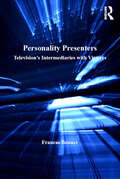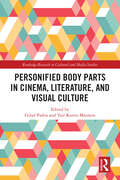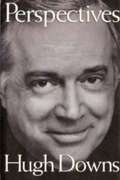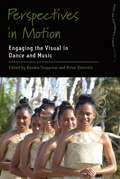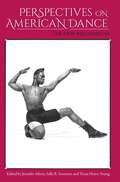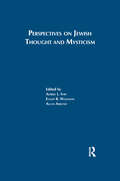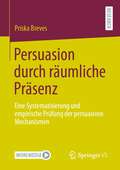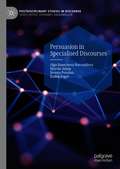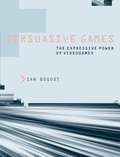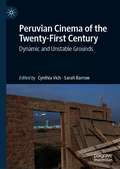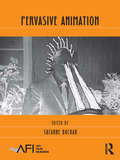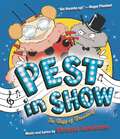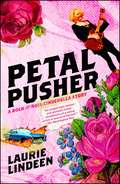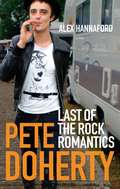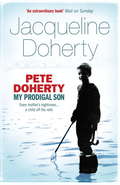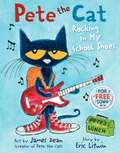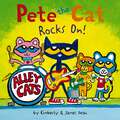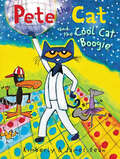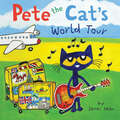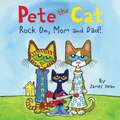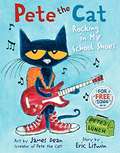- Table View
- List View
Personality Presenters: Television's Intermediaries with Viewers
by Frances BonnerTelevision presenters are key to the sociability of the medium, speaking directly to viewers as intermediaries between audiences and those who are interviewed, perform or compete on screen. As targets of both great affection and derision from viewers and the subjects of radio, internet, magazine and newspaper coverage, many have careers that have lasted almost as long as post-war television itself. Nevertheless, as a profession, television presenting has received little scholarly attention. Personality Presenters explores the role of the television presenter, analysing the distinct skills possessed by different categories of host and the expectations and difficulties that exist with regard to the promotion of the various films, books, consumer and cultural products with which they are associated. The close involvement of presenters with the content that they present is examined, while the impact of the presenters' own celebrity on the tasks that they perform is scrutinised. With a focus on non-fiction entertainment shows such as game shows, lifestyle and reality shows, chat, daytime and talk shows, this book explores issues of consumer culture, advertising and celebrity, as well as the connection of presenters with ethical issues. Offering detailed case studies of internationally recognised presenters, as well comparisons between national presenters from the UK and Australia, Personality Presenters provides a rich discussion of television presenters as significant conduits in the movement of ideas. As such, it will appeal to sociologists as well as those working in the fields of popular culture, cultural and media studies and cultural theory.
Personen beschreiben, Leben erzählen: Die Fernsehporträts von Georg Stefan Troller und Hans-Dieter Grabe
by Christian HißnauerDas jeweils einzigartige Œuvre von Georg Stefan Troller und Hans-Dieter Grabe wird hier erstmals werk- und fernsehhistorisch umfassend analysiert. Ausführlich werden die dokumentarischen Methoden dieser wichtigen Wegbereiter des deutschen Fernsehdokumentarismus erläutert und ihre dramaturgischen und ästhetischen Konzepte beschrieben.
Personified Body Parts in Cinema, Literature, and Visual Culture (Routledge Research in Cultural and Media Studies)
by Gilad Padva Yair Koren-MaimonPersonified Body Parts in Cinema, Literature, and Visual Culture investigates the power of personifying body parts in cinema, television, visual culture, literature, erotica, folklore, and mystique.Culturally, socially, and poetically exposing hidden aspects and subtleties of human existentialism, this book vigorously questions and problematizes numerous artistic, aesthetic, technological, naïve, and macabre manipulations of body parts for various purposes. A diverse team of authors explore how scribing human traits to limbs, eyes, brains, genitalia, hearts, and other inner organs is grotesque and aesthetic, repealing and appealing, intimidating and intimate, rude and enjoyable, material and spiritual, surprising and mundane. Personified organs are interrelated with bodily integrity, visceral aesthetics, distorted nature, social anxiety and acceptability, cultural classifications and hierarchies, and dissident innovativeness andradicalism.This interdisciplinary volume involves body studies; cinema, television, and media studies; literature studies; cultural, intercultural, and countercultural studies; mythology and folklore studies; gender, sexuality, trans and queer studies; ethnicities and postcolonialism; and art history.
Perspectives
by Hugh DownsEssays covering many subjects and interests by one of television's icons.
Perspectives in Motion: Engaging the Visual in Dance and Music (Dance and Performance Studies #15)
by Kendra Stepputat Brian DiettrichFocusing on visual approaches to performance in global cultural contexts, Perspectives in Motion explores the work of Adrienne L. Kaeppler, a pioneering researcher who has made a number of interdisciplinary contributions over five decades to dance and performance studies. Through a diverse range of case studies from Oceania, Asia, and Europe, and interdisciplinary approaches, this edited collection offers new critical and ethnographic frameworks for understanding and experiencing practices of music and dance across the globe.
Perspectives in Motion: Engaging the Visual in Dance and Music (Dance and Performance Studies #15)
by Kendra Stepputat Brian DiettrichFocusing on visual approaches to performance in global cultural contexts, Perspectives in Motion explores the work of Adrienne L. Kaeppler, a pioneering researcher who has made a number of interdisciplinary contributions over five decades to dance and performance studies. Through a diverse range of case studies from Oceania, Asia, and Europe, and interdisciplinary approaches, this edited collection offers new critical and ethnographic frameworks for understanding and experiencing practices of music and dance across the globe.
Perspectives on American Dance: The New Millennium
by Jennifer Atkins, Sally R. Sommer, and Tricia Henry YoungDancing embodies cultural history and beliefs, and each dance carries with it features of the place where it originated. Influenced by different social, political, and environmental circumstances, dances change and adapt. American dance evolved in large part through combinations of multiple styles and forms that arrived with each new group of immigrants. Perspectives on American Dance is the first anthology in over twenty-five years to focus exclusively on American dance practices across a wide span of American culture. This volume and its companion show how social experience, courtship, sexualities, and other aspects of life in America are translated through dancing into spatial patterns, gestures, and partner relationships. This volume of Perspectives on American Dance features essays by a young generation of authors who write with familiarity about their own era, exploring new parameters of identity and evaluating a wide variety of movement practices being performed in spaces beyond traditional proscenium stages. Topics include "dorky dancing" on YouTube; same-sex competitors on the TV show So You Think You Can Dance; racial politics in NFL touchdown dances; the commercialization of flash mobs; the connections between striptease and corporate branding; how 9/11 affected dance; the criminalization of New York City club dancing; and the joyous ironies of hipster dance. This volume emphasizes how dancing is becoming more social and interactive as technology opens up new ways to create and distribute dance. The accessible essays use a combination of movement analysis, thematic interpretation, and historical context to convey the vitality and variety of American dance. They offer new insights on American dance practices while simultaneously illustrating how dancing functions as an essential template for American culture and identity. Contributors: Jennifer Atkins | Jessica Berson | J. Ellen Gainor | Patsy Gay | Ansley Jones | Kate Mattingly | Hannah Schwadron | Sally Sommer, Ph.D. | Ina Sotirova | Dawn Springer | Michelle T. Summers | Latika L. Young | Tricia Henry Young
Perspectives on Jewish Though
by IvryFirst Published in 1998. Routledge is an imprint of Taylor & Francis, an informa company.
Perspektiven filmischer Überwindung der bipolaren Geschlechternorm durch Rekurs auf mythisches Potenzial
by Lioba SchlösserDieses Buch umfasst eine filmanalytische Betrachtung filmischer Interpretationen des Androgyniemotivs. Rückbezogen auf dessen mythische Ursprünge in Ovids Metamorphosen und Platons Kugelmenschenmythos wird nachvollzogen, inwieweit diese Darstellungen auf mythische Ursprungsgeschichten verweisen. Dazu wird auf Mythenforschung, körper- und blicktheoretische Thesen, Gender- und Queer Theorie sowie filmästhetische Ansätze zurückgegriffen. Es erfolgt eine Analyse ausgewählter Filmsequenzen aus internationalen Spiel- und Animationsfilmen, um theoretische Aspekte und Thesen nachvollziehbar darzulegen. Es wird vermutet, dass filminhärente Rekurse auf einzelne Mytheme helfen, die Thematik um Mehrgeschlechtlichkeit, nicht normative Sexualitäten und alternative sexuelle Identitäten medial verhandelbar zu machen. So können geschlechtliche Oppositionen dekonstruiert, Macht- und Hierarchiebeziehungen zwischen ihnen offengelegt und kritisch hinterfragt werden. Ziel der Studie ist demzufolge, das Motiv der Androgynie und seine filmischen Darstellungsweisen durch einen dichten theoretischen Rahmen möglichst präzise zu fassen, um herauszustellen, welche Rolle der Mythos als Ursprung des Motivs innerhalb der filmischen Darstellungen spielt.
Persuasion durch räumliche Präsenz: Eine Systematisierung und empirische Prüfung der persuasiven Mechanismen
by Priska BrevesDie persuasive Wirksamkeit immersiver Botschaften wurde schon mehrfach empirisch nachgewiesen. Die räumliche Präsenz wurde dabei als Mediator der Effekte identifiziert – wie genau dieser Persuasionsmechanismus allerdings abläuft, ist bisher ungeklärt. Daher wird die bisherige Forschung rund um die Wahrnehmung der räumlichen Präsenz in diesem Buch aufgearbeitet und systematisiert. Unterschiedliche Ansätze und Theorien werden dabei miteinander in Verbindung gesetzt und die Vermutungen anhand von drei empirischen Laborexperimente geprüft. Die Ergebnisse werden im Anschluss durch ein konzeptuelles Persuasionsmodell miteinander verbunden und ausführlich diskutiert.
Persuasion in Specialised Discourses (Postdisciplinary Studies in Discourse)
by Olga Dontcheva-Navratilova Martin Adam Renata Povolná Radek VogelThis book examines the concept of persuasion in written texts for specialist audiences in the English and Czech languages. By exploring a corpus of academic research articles, corporate reports, religious sermons and user manuals the authors aim to reveal similarities and differences in rhetorical strategies across cultures and genres. They draw on Biber and Conrad’s (2009) model for contextualising interaction in specialised discourses, Bell’s (1997) framework for the analysis of participants roles, Swales’ (1990) genre analysis approach for considering genre constraints and Hyland’s (2005) metadiscourse model for investigating writer-reader interaction. The result is a book which will appeal to researchers and students in Discourse Studies, especially those with an interest in genre and rhetorical strategies.
Persuasive Games
by Ian BogostVideogames are an expressive medium, and a persuasive medium; they represent how real and imagined systems work, and they invite players to interact with those systems and form judgments about them. In this innovative analysis, Ian Bogost examines the way videogames mount arguments and influence players. Drawing on the 2,500-year history of rhetoric, the study of persuasive expression, Bogost analyzes rhetoric's unique function in software in general and videogames in particular. The field of media studies already analyzes visual rhetoric, the art of using imagery and visual representation persuasively. Bogost argues that videogames, thanks to their basic representational mode of procedurality (rule-based representations and interactions), open a new domain for persuasion; they realize a new form of rhetoric. Bogost calls this new form "procedural rhetoric," a type of rhetoric tied to the core affordances of computers: running processes and executing rule-based symbolic manipulation. He argues further that videogames have a unique persuasive power that goes beyond other forms of computational persuasion. Not only can videogames support existing social and cultural positions, but they can also disrupt and change these positions themselves, leading to potentially significant long-term social change. Bogost looks at three areas in which videogame persuasion has already taken form and shows considerable potential: politics, advertising, and learning. Bogost is both an academic researcher and videogame designer, and Persuasive Games reflects both theoretical and a game design goals.
Peruvian Cinema of the Twenty-First Century: Dynamic and Unstable Grounds
by Sarah Barrow Cynthia VichThis is the first English-language book to provide a critical panorama of the last twenty years of Peruvian cinema. Through analysis of the nation’s diverse modes of filmmaking, it offers an insight into how global debates around cinema are played out on and off screen in a distinctive national context.The insertion of post-conflict Peru within neoliberalism resulted in widespread commodification of all areas of life, significantly impacting cinema culture. Consequently, the principal structural concept of this collection is the interplay between film production and market forces, an interaction which makes dynamism and instability the defining features of 21st-century Peruvian cinema.
Pervasive Animation (AFI Film Readers)
by Suzanne BuchanThis new addition to the AFI Film Readers series brings together original scholarship on animation in contemporary moving image culture, from classic experimental and independent shorts to digital animation and installation. The collection - that is also a philosophy of animation - foregrounds new critical perspectives on animation, connects them to historical and contemporary philosophical and theoretical contexts and production practice, and expands the existing canon. Throughout, contributors offer an interdisciplinary roadmap of new directions in film and animation studies, discussing animation in relationship to aesthetics, ideology, philosophy, historiography, visualization, genealogies, spectatorship, representation, technologies, and material culture.
Pest In Show
by Victoria JamiesonLadybug knows she was born to be a star. She can't wait to sing and dance in her newest musical, which will be her best show ever. Ladybug won't let anyone get in the way of her performance...especially her little brother, Fly. He's a pest! But Fly is determined to be part of the act, no matter what. Is the show big enough for this sibling rivalry?This sing-along, read-aloud, funny tribute to the budding Broadway star in all of us is sure to be a smash hit, and shows that working together really does pay off.
Petal Pusher
by Laurie LindeenSet in the years between the meteoric launches of Madonna and Courtney Love, Petal Pusher takes readers on a stirring journey across rock and roll, from the big-haired 1980s to the grunge-filled 1990s, when Laurie Lindeen brought her all-girl band, Zuzu's Petals, to compete in the indie rock arena. Minneapolis in the eighties was a musical hotbed, the land of 10,000 lakes and 10,000 bands that gave birth to Prince, the Replacements, and Soul Asylum. For Laurie Lindeen it was the perfect place to launch her rock-and-roll dream. She moved to the city with her best friends Phyll ("Annie Oakley meets Patsy Cline") and Coleen ("former cheerleader gone off the arty deep end") to crash in decrepit apartments and coax punk rock from crappy used guitars. But unbeknownst to her friends, Laurie has a secret in her past -- a diagnosis of multiple sclerosis that fuels her passion to make it big on the local, national, and international rock scene. With inspiring determination, Laurie and her Zuzu's Petals survive the many challenges of being underdogs in a man's world. Then Laurie is thrown a curveball when she falls for Paul Westerberg of Replacements fame and reevaluates exactly what it means to "make it big." By turns hilarious and heartrending, Petal Pusher is a brilliant behind-the-scenes look at music on the front lines, and the awe-inspiring tale of one woman's fight against disease and the disillusionment of life in the rock underground.
Pete Doherty: Last of the Rock Romantics
by Alex HannafordPete Doherty, erstwhile singer with The Libertines, is a British icon. Whether he is playing impromptu gigs in his front room or performing at Live 8, he possesses a sense of drama and expectation not seen in a performer since Sid Vicious. He is enigmatic, charismatic and thoroughly entertaining. Since leaving The Libertines, his life has become something of a rock 'n' roll soap opera where rumours of crack addiction abound, gossip about his relationship with Kate Moss is rife, and predictions for his future vary wildly.Written by Alex Hannaford, former rock and pop editor on the London Evening Standard, and with a brand new foreword by Pete's mum, Jackie Doherty, this is the definitive biography of Pete Doherty.
Pete Doherty: My Prodigal Son
by Jacqueline DohertyFor over three years Jacqueline Doherty has been watching her rock star son's messy descent into drug addiction. Every step of the way has been charted by a hungry media. And every step of the way has been agony for a loving mum. Pete Doherty's celebrity means that his addiction has become public property. But Jacqueline is a private person and her painful account is that of any mum - or any parent - trying to help a child in trouble. This is the compelling story of Pete's childhood, his burgeoning talent, his success as a musician and his drug addiction, set against the backdrop of his loving relationship with his mother and his family. It is a moving memoir of how a happy, middle-class family is coping with a family member opting to love drugs more than he loves them, or himself. It is a memoir that will offer hope to other mothers and families in a similar situation.
Pete Doherty: My Prodigal Son
by Jacqueline DohertyFor over three years Jacqueline Doherty has been watching her rock star son's messy descent into drug addiction. Every step of the way has been charted by a hungry media. And every step of the way has been agony for a loving mum. Pete Doherty's celebrity means that his addiction has become public property. But Jacqueline is a private person and her painful account is that of any mum - or any parent - trying to help a child in trouble. This is the compelling story of Pete's childhood, his burgeoning talent, his success as a musician and his drug addiction, set against the backdrop of his loving relationship with his mother and his family. It is a moving memoir of how a happy, middle-class family is coping with a family member opting to love drugs more than he loves them, or himself. It is a memoir that will offer hope to other mothers and families in a similar situation.
Pete the Cat Rocking in My School Shoes: A Back To School Book For Kids (Pete The Cat Ser.)
by Eric LitwinPete the cat wears his school shoes while visiting the library, the lunchroom, the playground, and more while singing his special song.
Pete the Cat Rocks On! (Pete the Cat)
by Kimberly Dean James DeanRock on with Pete the Cat in this groovy storybook about keeping calm and rocking on by New York Times bestselling author-illustrator team Kimberly and James Dean. Includes over thirty stickers!Pete the Cat can’t wait to rock out at the Alley Cats concert! But when the band never comes onstage, it’s up to Pete to find them. Will Pete have the right instruments to help the Alley Cats save the show? Find out in this rockin’ story full of problem-solving and friendship! Includes over thirty awesome stickers.
Pete the Cat and the Cool Cat Boogie (Pete the Cat)
by Kimberly Dean James DeanPut on your dancing shoes—Pete is ready to boogie!Pete is learning a new dance—the Cool Cat Boogie! When he hears a groovy beat, he’s full of happy in his feet. But when Grumpy Toad tells him, “Pete, you dance all wrong!” Pete is determined to become a better dancer.With the help of his friends and some wise words from Owl, Pete learns that he’s his grooviest when he’s being himself. Includes step-by-step dance moves so readers can dance along with Pete!Join Pete the Cat in this groovy story from New York Times bestselling author-illustrator team James and Kimberly Dean! Don't miss Pete's other adventures, including Pete the Cat: I Love My White Shoes, Pete the Cat: Rocking in My School Shoes, Pete the Cat and His Four Groovy Buttons, Pete the Cat Saves Christmas, Pete the Cat and His Magic Sunglasses, Pete the Cat and the Bedtime Blues, Pete the Cat and the New Guy, Pete the Cat and the Missing Cupcakes, Pete the Cat and the Perfect Pizza Party, and Pete the Cat: Crayons Rock!
Pete the Cat's World Tour (Pete the Cat)
by Kimberly Dean James DeanDon't forget your passport...it's Pete the Cat's groovy tour around the world! In Pete the Cat's World Tour, from New York Times bestselling author and illustrator James Dean, Pete the Cat and his band have packed up their bags and are ready to perform all over the globe. But what’s the fun in globe-trotting if you don’t go out exploring?From Mexico to Iceland, Pete and his friends get a taste of what each country has to offer.
Pete the Cat: Rock On, Mom and Dad! (Pete the Cat)
by Kimberly Dean James DeanRock out with Pete the Cat in New York Times bestselling artist James Dean's Pete the Cat: Rock On, Mom and Dad!Mom and Dad do so much for Pete that he wants to thank them with a special surprise. But what can Pete do that will show Mom and Dad how much he loves them?In this groovy story, Pete learns that it’s not what you do but how you do it that matters, so long as it comes from the heart. Young readers will love watching Pete surprise Mom and Dad with something totally awesome.Moms and dads looking for a Mother's Day or Father's Day present for their child to give should consider Rock On, Mom and Dad!
Pete the Cat: Rocking in my School Shoes (Into Reading, Big Book Module 1)
by Eric Litwin James DeanNIMAC-sourced textbook <P><P>Time to head back to school with this bestselling groovy Pete the Cat book! <P><P>Pete the Cat is rocking in his school shoes. Pete discovers the library, the lunch room, the playground, and lots of other cool places at school. And no matter where he goes, Pete never stops moving and grooving and singing his song...because it’s all good. <P><P>The fun never stops—download the free groovin’ song. <P><P>Lexile Measure: AD430L
